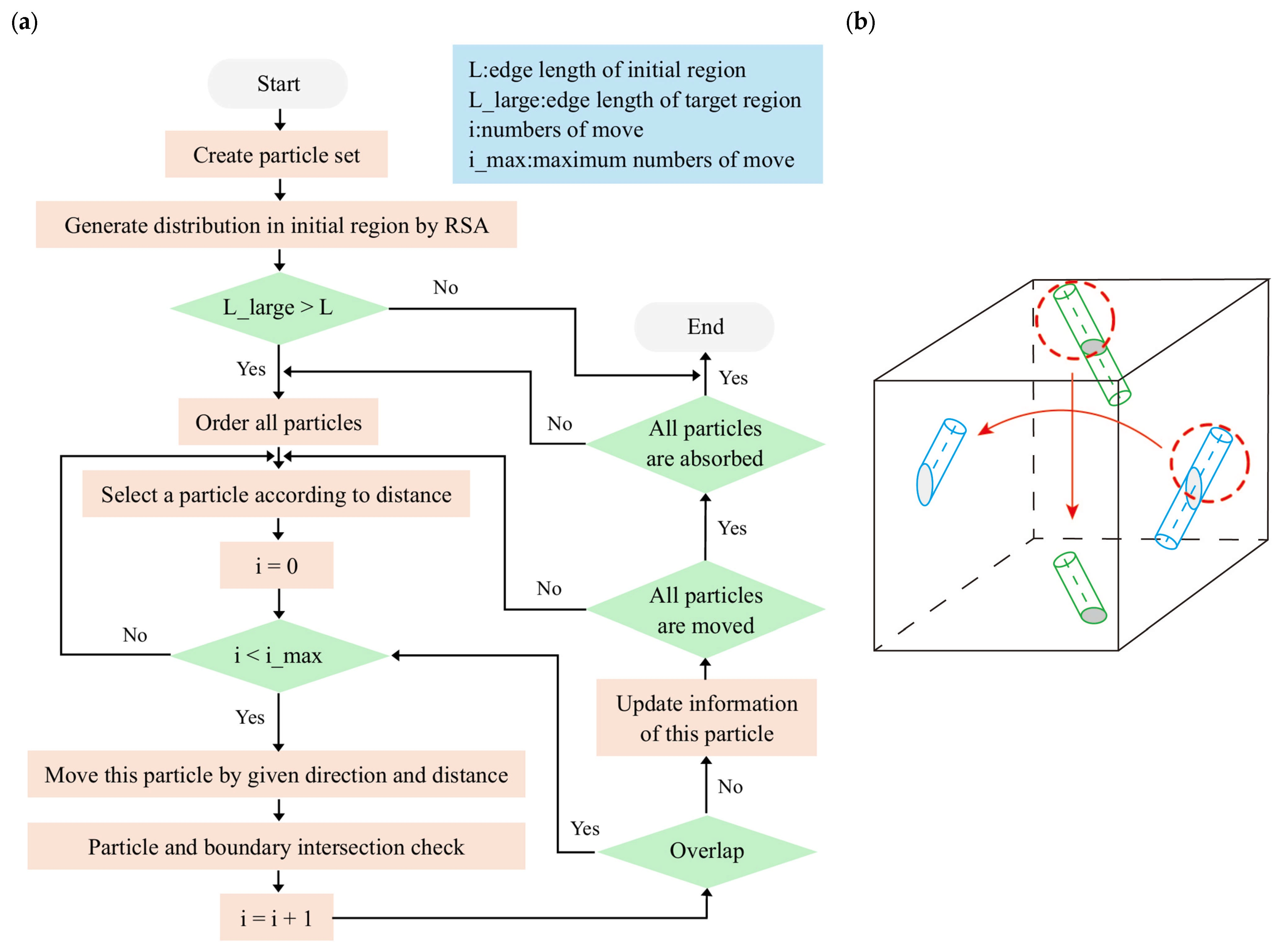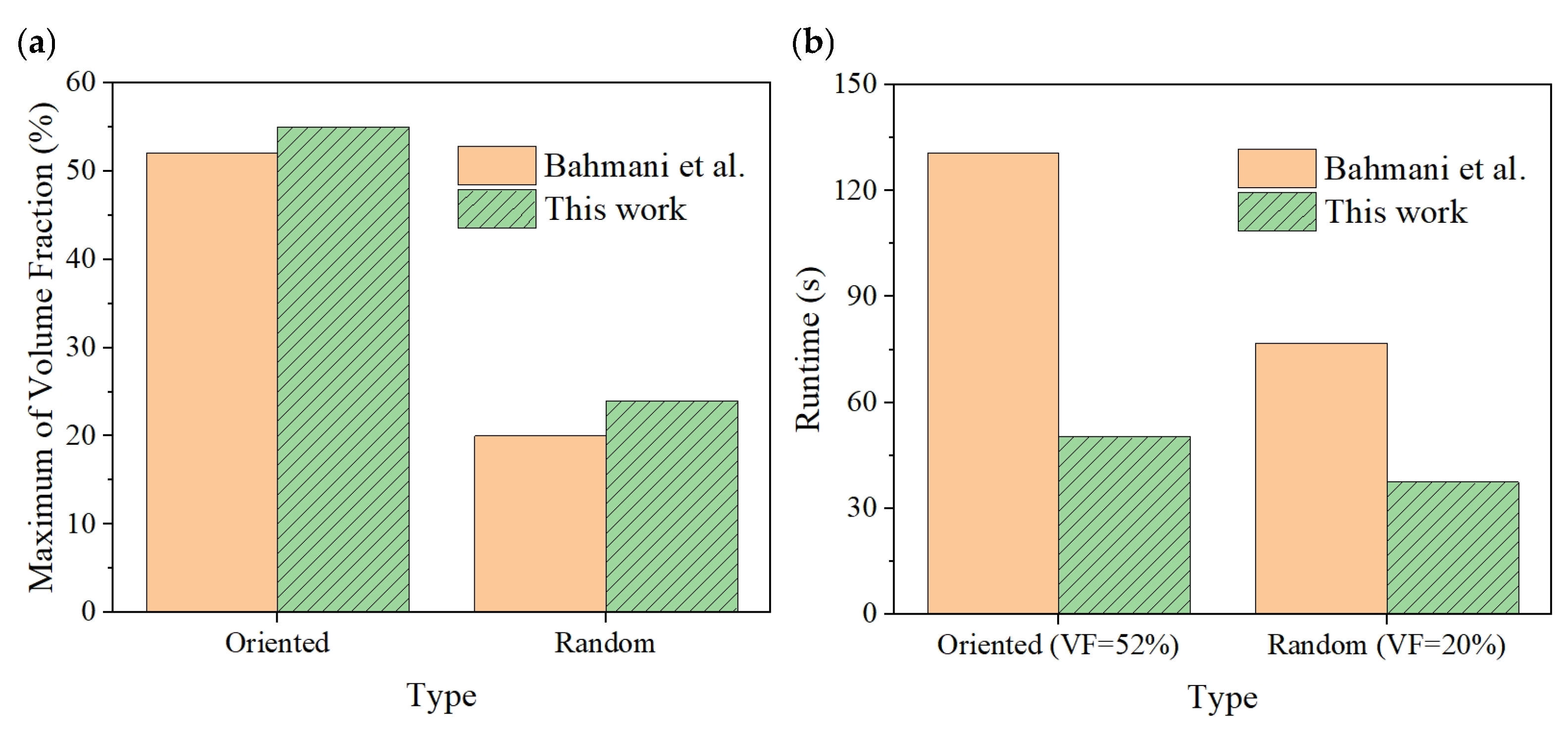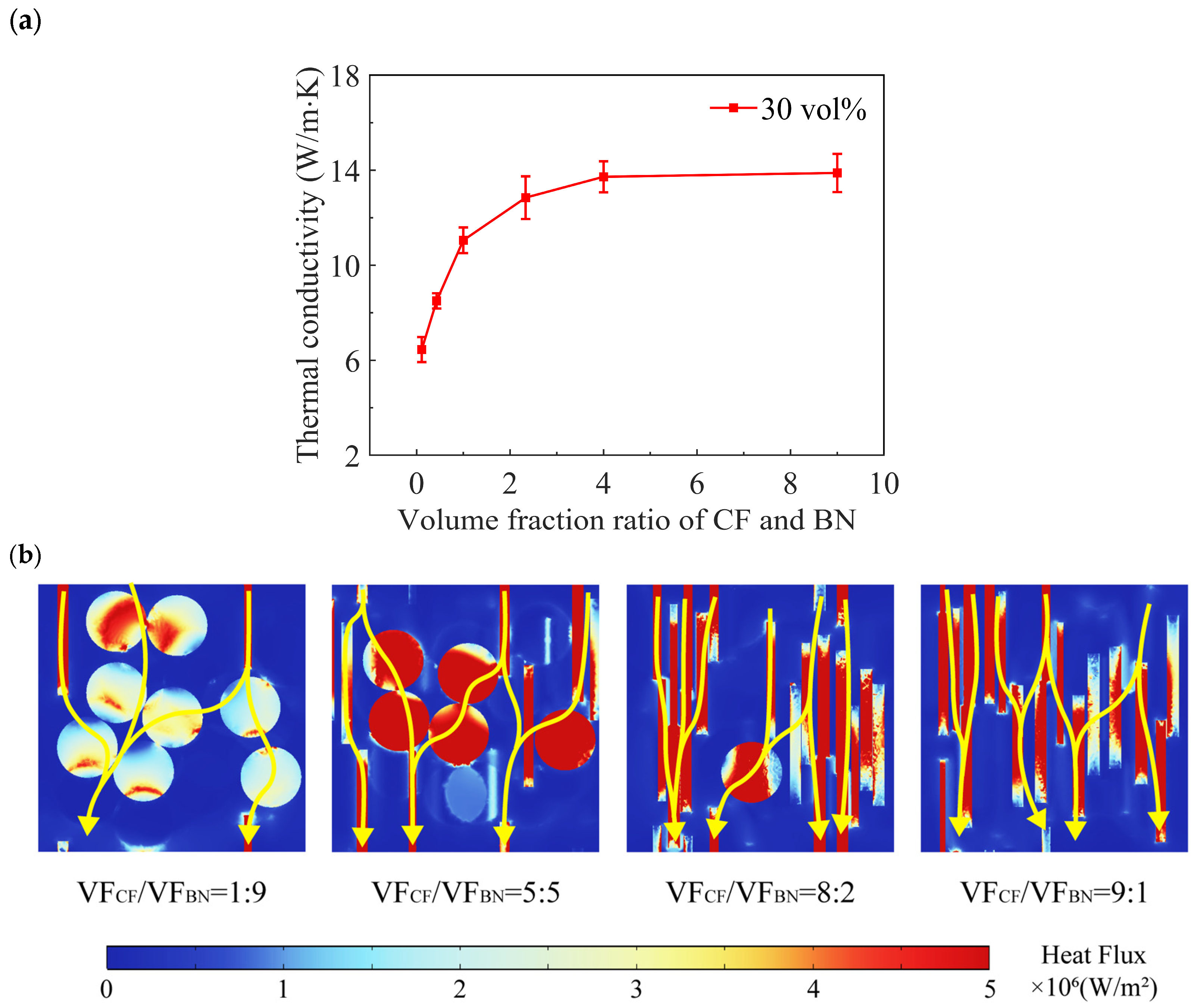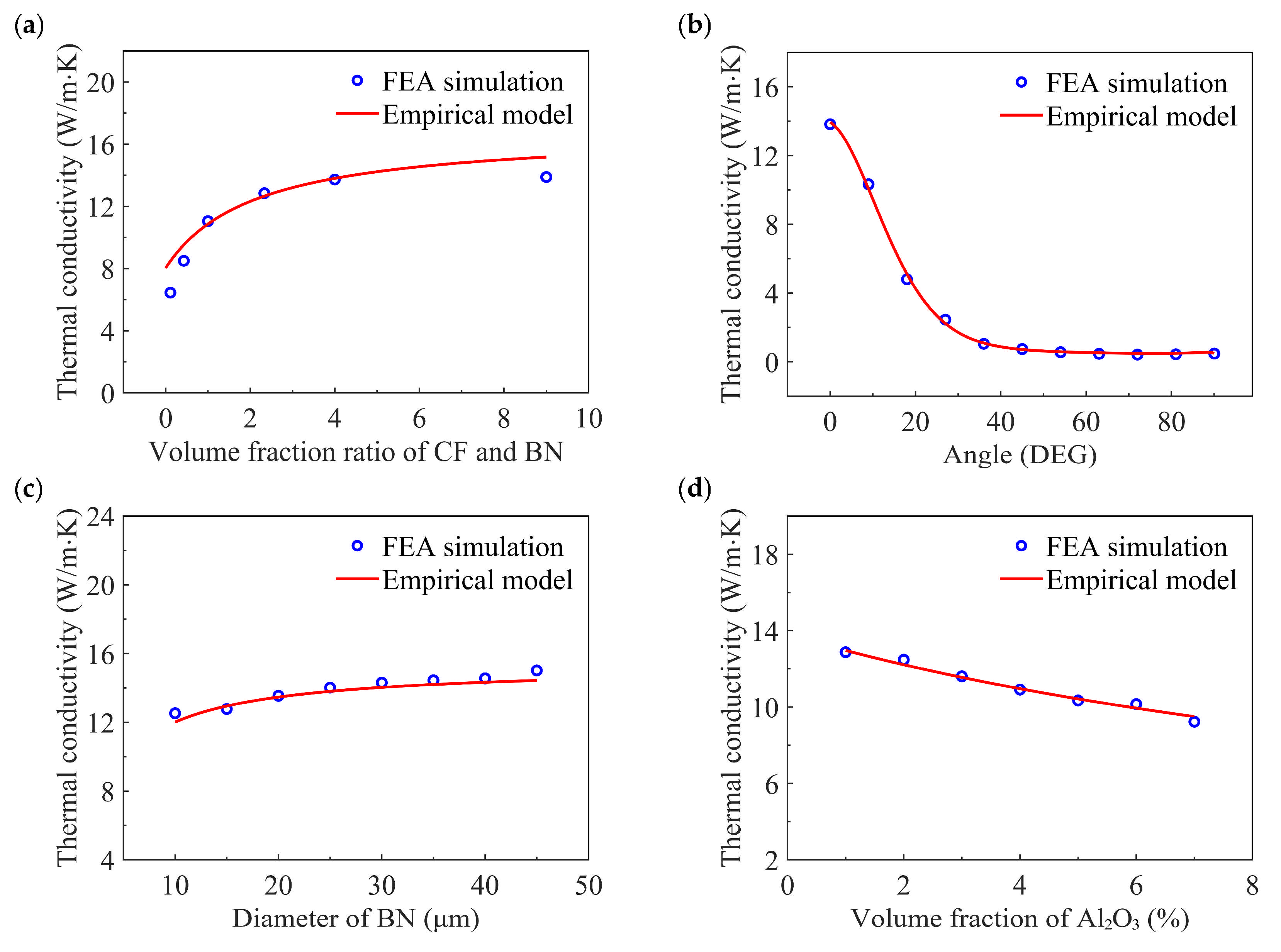A Numerical Study on Heat Transfer Enhancement Mechanism of Composite Materials Based on Oriented Multi-Dimensional Fillers
Abstract
1. Introduction
2. Method
2.1. Generation of Geometric Model
2.1.1. Ordered Aggregation Algorithm
2.1.2. Particle Collision Detection Algorithm
2.2. Finite Element Analysis
2.3. Model Validation
3. Results and Discussion
3.1. Effects of BN/CF Volume Fraction Ratio
3.2. Effect of the Orientation Angle
3.3. Effect of the BN Particle Diameter
3.4. Effect of the Al2O3 Volume Fraction
3.5. Equation of Thermal Conductivity
4. Conclusions
- Fillers with high aspect ratios, such as CF and BN, are more effective in constructing thermal pathways. In the CF-BN binary system, BN acts as nodes, and CF serves as bridges, with optimal performance achieved at a CF/BN volume fraction ratio of 4, reaching a thermal conductivity of 13.72 W/m∙K.
- The orientation angle of fillers critically influences thermal conductivity, with a 17.68 times increase observed when the angle decreases from 45° to 0°, reaching the value of 13.82 W/m∙K. A mathematical model (Equation (8)) was established to quantify this correlation.
- As the diameter of BN increases, the thermal conductivity gradually increases, but the rate of increase is small. The diameter of BN affects the synergistic effect between CF and BN, with larger diameters of BN being more beneficial for the construction of thermal pathways.
- The ternary system (CF-BN-Al2O3) shows no significant advantage, as the thermal conductivity decreases by 0.60 W/m∙K per 1 vol% increase in Al2O3, indicating that two-dimensional fillers satisfy the requirements of constructing thermal pathways.
- The developed predictive model, based on thermal resistance theory, provides a computationally efficient tool for evaluating and optimizing composite thermal properties. The model’s accuracy is confirmed by its agreement with numerical results, offering practical utility for material design.
Author Contributions
Funding
Data Availability Statement
Conflicts of Interest
References
- Guo, Y.; Ruan, K.; Gu, J. Controllable thermal conductivity in composites by constructing thermal conduction networks. Mater. Today Phys. 2021, 20, 100449. [Google Scholar] [CrossRef]
- Chung, D.D.L. Performance of Thermal Interface Materials. Small 2022, 18, e2200693. [Google Scholar] [CrossRef] [PubMed]
- Atinafu, D.G.; Yun, B.Y.; Kim, Y.U.; Kim, S. Nanopolyhybrids: Materials, Engineering Designs, and Advances in Thermal Management. Small Methods 2023, 7, e2201515. [Google Scholar] [CrossRef] [PubMed]
- Zhang, X.D.; Zhang, Z.T.; Wang, H.Z.; Cao, B.Y. Thermal Interface Materials with High Thermal Conductivity and Low Young’s Modulus Using a Solid-Liquid Metal Codoping Strategy. ACS Appl. Mater. Interfaces 2023, 15, 3534–3542. [Google Scholar] [CrossRef]
- Sarvar, F.; Whalley, D.C.; Conway, P.P. Thermal Interface Materials—A Review of the State of the Art. In Proceedings of the 1st Electronic Systemintegration Technology Conference, Dresden, Germany, 5–7 September 2006. [Google Scholar]
- Zhao, C.; Li, Y.; Liu, Y.; Xie, H.; Yu, W. A critical review of the preparation strategies of thermally conductive and electrically insulating polymeric materials and their applications in heat dissipation of electronic devices. Adv. Compos. Hybrid Mater. 2022, 6, 27. [Google Scholar] [CrossRef]
- Yang, J.; Shen, X.; Yang, W.; Kim, J.K. Templating strategies for 3D-structured thermally conductive composites: Recent advances and thermal energy applications. Prog. Mater. Sci. 2023, 133, 101054. [Google Scholar] [CrossRef]
- Li, M.; Wang, M.; Hou, X.; Zhan, Z.; Wang, H.; Fu, H.; Lin, C.-T.; Fu, L.; Jiang, N.; Yu, J. Highly thermal conductive and electrical insulating polymer composites with boron nitride. Compos. Part B Eng. 2020, 184, 107746. [Google Scholar] [CrossRef]
- Yang, R.; Wang, Y.; Zhang, Z.; Xu, K.; Li, L.; Cao, Y.; Li, M.; Zhang, J.; Qin, Y.; Zhu, B.; et al. Highly oriented BN-based TIMs with high through-plane thermal conductivity and low compression modulus. Mater. Horiz. 2024, 11, 4064–4074. [Google Scholar] [CrossRef]
- Dong, H.; Liu, Z.; Guo, J.; Lv, S.; Huang, H.; Jiang, X. Vertically aligned carbon fiber/polydimethylsiloxane composites prepared by lyophilization with exceptional thermal conductivity and electromagnetic interference shielding performance. Chem. Eng. J. 2024, 490, 151620. [Google Scholar] [CrossRef]
- Wu, J.; Song, X.; Gong, Y.; Yang, W.; Chen, L.; He, S.; Lin, J.; Bian, X. Analysis of the heat conduction mechanism for Al2O3/Silicone rubber composite material with FEM based on experiment observations. Compos. Sci. Technol. 2021, 210, 108809. [Google Scholar] [CrossRef]
- Ma, H.; Gao, B.; Wang, M.; Yuan, Z.; Shen, J.; Zhao, J.; Feng, Y. Strategies for enhancing thermal conductivity of polymer-based thermal interface materials: A review. J. Mater. Sci. 2020, 56, 1064–1086. [Google Scholar] [CrossRef]
- Fu, L.; Kong, N.; Huang, M.; Tian, Y.; Yan, Y.; Wen, B.; Ye, C.; Huang, D.; Han, F. Compressible thermal interface materials with high through-plane thermal conductivity from vertically oriented carbon fibers. J. Alloys Compd. 2024, 987, 174200. [Google Scholar] [CrossRef]
- Huang, F.; Qin, W.; Shu, D.; Sun, J.; Li, J.; Meng, D.; Yue, W.; Wang, C. Steppingstone-inspired construction of high vertical thermal conductivity material with low carbon fiber content. Ceram. Int. 2023, 49, 32971–32978. [Google Scholar] [CrossRef]
- Ji, Y.; Han, S.; Zhang, Q.; Wu, H.; Guo, S.; Zhang, F.; Qiu, J. Constructing a highly vertically aligned network of h-BN/CF in silicone rubber composites: Achieving superior through-plane thermal conductivity and electrical insulation. Compos. Part B Eng. 2023, 266, 111024. [Google Scholar] [CrossRef]
- Yang, M.; Li, X.; Kang, G.; Chen, W. Understanding macroscopic thermal conduction in composites reinforced with 2D nanosheets. Compos. Sci. Technol. 2024, 248, 110450. [Google Scholar] [CrossRef]
- Sun, C.T.; Vaidya, R.S. Prediction of composite properties from a representative volume element. Compos. Sci. Technol. 1996, 56, 171–179. [Google Scholar] [CrossRef]
- Zong, R.; Liu, B.; Wang, S.; Jia, X.; Li, S.; Huai, X. Numerical simulation of heat transfer of highly filled composites with spherical alumina fillers. Compos. Sci. Technol. 2025, 263, 111064. [Google Scholar] [CrossRef]
- Tarantino, M.G.; Zerhouni, O.; Danas, K. Random 3D-printed isotropic composites with high volume fraction of pore-like polydisperse inclusions and near-optimal elastic stiffness. Acta Mater. 2019, 175, 331–340. [Google Scholar] [CrossRef]
- Ghossein, E.; Lévesque, M. A fully automated numerical tool for a comprehensive validation of homogenization models and its application to spherical particles reinforced composites. Int. J. Solids Struct. 2012, 49, 1387–1398. [Google Scholar] [CrossRef]
- Tian, W.; Chao, X.; Fu, M.W.; Qi, L. An advanced method for efficiently generating composite RVEs with specified particle orientation. Compos. Sci. Technol. 2021, 205, 108647. [Google Scholar] [CrossRef]
- Bahmani, A.; Nooraie, R.Y.; Willett, T.L.; Montesano, J. A sequential mobile packing algorithm for micromechanical assessment of heterogeneous materials. Compos. Sci. Technol. 2023, 237, 110008. [Google Scholar] [CrossRef]
- Tian, W.; Chao, X.; Fu, M.W.; Qi, L. An algorithm for generation of RVEs of composites with high particle volume fractions. Compos. Sci. Technol. 2021, 207, 108714. [Google Scholar] [CrossRef]
- Dai, J.S. Euler–Rodrigues formula variations, quaternion conjugation and intrinsic connections. Mech. Mach. Theory 2015, 92, 144–152. [Google Scholar] [CrossRef]
- Xue, Y.; Li, X.; Wang, H.; Zhao, F.; Zhang, D.; Chen, Y. Improvement in thermal conductivity of through-plane aligned boron nitride/silicone rubber composites. Mater. Des. 2019, 165, 107580. [Google Scholar] [CrossRef]
- Liu, H.; Su, X.; Fu, R.; Wu, B.; Chen, X. The flexible film of SCF/BN/PDMS composites with high thermal conductivity and electrical insulation. Compos. Commun. 2021, 23, 100573. [Google Scholar] [CrossRef]
- Feng, Q.k.; Zhang, D.L.; Zha, J.w.; Yin, L.j.; Dang, Z.m. Thermal, electrical, and mechanical properties of addition-type liquid silicone rubber co-filled with Al2O3 particles and BN sheets. J. Appl. Polym. Sci. 2020, 137, 49399. [Google Scholar] [CrossRef]
- Ngo, I.-L.; Byon, C. A generalized correlation for predicting the thermal conductivity of composite materials. Int. J. Heat Mass Transf. 2015, 83, 408–415. [Google Scholar] [CrossRef]
- Sudhindra, S.; Kargar, F.; Balandin, A.A. Noncured Graphene Thermal Interface Materials for High-Power Electronics: Minimizing the Thermal Contact Resistance. Nanomaterials 2021, 11, 1699. [Google Scholar] [CrossRef]









Disclaimer/Publisher’s Note: The statements, opinions and data contained in all publications are solely those of the individual author(s) and contributor(s) and not of MDPI and/or the editor(s). MDPI and/or the editor(s) disclaim responsibility for any injury to people or property resulting from any ideas, methods, instructions or products referred to in the content. |
© 2025 by the authors. Licensee MDPI, Basel, Switzerland. This article is an open access article distributed under the terms and conditions of the Creative Commons Attribution (CC BY) license (https://creativecommons.org/licenses/by/4.0/).
Share and Cite
Luo, H.; Liu, B.; Dou, W.; Zhou, X.; Jia, X.; Chen, L. A Numerical Study on Heat Transfer Enhancement Mechanism of Composite Materials Based on Oriented Multi-Dimensional Fillers. Electron. Mater. 2025, 6, 19. https://doi.org/10.3390/electronicmat6040019
Luo H, Liu B, Dou W, Zhou X, Jia X, Chen L. A Numerical Study on Heat Transfer Enhancement Mechanism of Composite Materials Based on Oriented Multi-Dimensional Fillers. Electronic Materials. 2025; 6(4):19. https://doi.org/10.3390/electronicmat6040019
Chicago/Turabian StyleLuo, Hongjie, Bin Liu, Wenbin Dou, Xinzhan Zhou, Xiao Jia, and Lin Chen. 2025. "A Numerical Study on Heat Transfer Enhancement Mechanism of Composite Materials Based on Oriented Multi-Dimensional Fillers" Electronic Materials 6, no. 4: 19. https://doi.org/10.3390/electronicmat6040019
APA StyleLuo, H., Liu, B., Dou, W., Zhou, X., Jia, X., & Chen, L. (2025). A Numerical Study on Heat Transfer Enhancement Mechanism of Composite Materials Based on Oriented Multi-Dimensional Fillers. Electronic Materials, 6(4), 19. https://doi.org/10.3390/electronicmat6040019





